2. 城市生活污水资源化利用技术国家地方联合工程实验室, 苏州 215009;
3. 江苏高校水处理技术与材料协同创新中心, 苏州 215009
2. National and Local Joint Engineering Laboratory of Municipal Sewage Resource Utilization Technology, Suzhou 215009, China;
3. Jiangsu High Education Collaborative Innovation Center of Water Treatment Technology and Material, Suzhou 215009, China
作为一种全自养生物脱氮工艺, 单级亚硝化-厌氧氨氧化系统(one-stage partial nitritation and ANAMMOX or PN/A system)是基于好氧氨氧化菌(AOB)与厌氧氨氧化菌(AMX)的共生与协同作用而建立的[1, 2].首先, AOB以溶解氧(DO)为电子受体, 将进水中部分氨氮(NH4+-N)氧化为亚硝态氮(NO2--N), 即发生亚硝化反应, 方程见式(1).随后, AMX在缺氧环境中将剩余的NH4+-N和新生成的NO2--N一同转化为氮气, 并生成少量的硝态氮(NO3--N), 通过厌氧氨氧化反应实现脱氮目标, 见式(2).

|
(1) |

|
(2) |
PN/A工艺的总反应式如式(3)所示:

|
(3) |
与传统全程硝化-反硝化过程相比, PN/A工艺具有曝气能耗低、不依赖外部碳源、反应器结构简单和污泥产量少等优点[1, 3].由于自养微生物生长速率缓慢, 利用生物截留能力较强的颗粒污泥, 有利于启动高性能PN/A反应器, 其总氮(TN)去除负荷可达3.2 kg·(m3·d)-1以上[4~6], 远高于絮体污泥系统的0.5~0.8 kg·(m3·d)-1[7, 8].通常认为, 在全自养脱氮颗粒污泥中, AOB主要分布于颗粒表面70~200 μm以内的好氧区, AMX则集中于污泥内层的厌氧区域内(距表面300 μm以上).尽管目前有关环境因素对AOB或AMX活性的影响研究已较为充分, 但为了考察PN/A工艺运行的稳定性, 有必要建立颗粒污泥中两类脱氮功能菌协同效应对环境条件变化的响应关系[2, 9].
鉴于此, 本文以成熟全自养脱氮颗粒污泥为研究对象, 采用MiSeq高通量测序技术对微生物菌群结构进行分析, 并基于单因子批次实验, 系统考察了DO浓度、温度(t)、初始NH4+-N浓度和溶液pH对颗粒污泥脱氮性能的影响, 详细阐述了实现AOB与AMX之间高效协同作用的适宜条件及其主要原因.
1 材料与方法 1.1 自养颗粒污泥颗粒污泥取自一个完全混合流PN/A反应器(CSTR)中, 装置结构图详见文献[4].反应器进水为人工配置的无机含氮废水, 氨氮容积负荷约为2.0 kg·(m3·d)-1, 水温、DO浓度和pH分别控制在(30±1)℃、(1.0±0.1) mg·L-1和7.9±0.1.在稳态条件下反应器运行180 d以上, NH4+-N、TN去除率分别超过89%和77%, 反应器中的颗粒污泥粒径分布在0.2~2.0 mm之间, 平均粒径1.0 mm, 其中大于0.8 mm的颗粒占到总质量的65.8%.
1.2 批次实验方法从PN/A反应器中取出一定量颗粒污泥后, 使用0.9%生理盐水清洗3次, 去除残留基质, 分装于150 mL具橡胶塞锥形瓶中.依据DO、t、初始NH4+-N浓度和溶液pH条件设置不同的分组.每个锥形瓶中分别装入基质溶液90 mL(除NH4+-N浓度外, 其他成分与进水相同), 污泥浓度(MLSS)控制为(4 360±20) mg·L-1.将锥形瓶置于振荡器中, 控制振荡速度启动反应过程, 每个反应条件至少设3组平行实验.反应期间, 定时取上清液测定NH4+-N、NO3--N、NO2--N和TN浓度, 并基于线性段拟合, 分别计算NH4+-N比降解速率[q(NH4+-N)]、NO3--N比累积速率[q(NO3--N)]、NO2--N比累积速率[q(NO2--N)]和TN比降解速率[q(TN)], 单位mg·(g·h)-1, 以MLVSS计[10].
由式(1)~(3)可知, q(NH4+-N)、q(NO2--N)与q(TN)、q(NO3--N)及其相互关系可用于表征颗粒污泥中AOB、AMX的协同作用.
1.3 分析方法NH4+-N、NO3--N、NO2--N和TN指标分别采用纳氏试剂光度法、紫外分光光度法、N-(1-萘基)-乙二胺光度法和过硫酸钾氧化-紫外分光光度法测定. MLSS和MLVSS采用标准重量法测定.溶液pH和DO浓度采用多水质分析仪(903P般特)测定.污泥形态使用OLYMPUS CX41型显微镜观察.溶液中游离氨(FA)浓度的计算方法详见文献[11].
1.4 微生物高通量测序分析在反应器运行的第180d取适量污泥样品, 使用E.Z.N.A Soil DNA试剂盒(Omega Bio-tek, Norcross, GA, U.S.)提取并纯化微生物总DNA.以16S rRNA中338F(5-ACTCCTACGGGAGGCAGCA-3)和806R(5-GGACTACHVGGGTWTCTAAT-3)为细菌特征引物, 采用20 μL混合反应体系, 在GeneAmp 9700 (ABI)型PCR扩增仪上完成目标片段扩增.随后, 基于Illumina MiSeq PE300平台, 对PCR扩增产物进行高通量测序, 并进行细菌分类学等相关分析, 详见文献[12].
2 结果与讨论 2.1 颗粒污泥的微生物菌群结构本研究使用PN/A颗粒污泥, 深红棕色, 呈密实规则的球状, 平均粒径为1.0 mm(颗粒形态见图 1), 5 min污泥沉降指数(SVI5)约为26 mL·g-1.
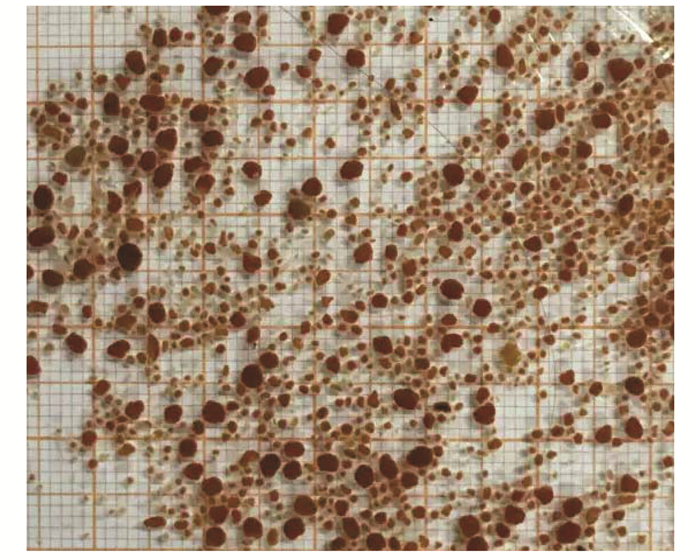
|
图 1 PN/A颗粒污泥的形态 Fig. 1 Morphology of the PN/A granular sludge |
高通量测序的结果表明, 涵盖活性污泥中主要脱氮功能菌的Proteobacteria门在颗粒污泥中占据主导地位(50.9%), 其次分别为Bacteroidetes门(13.8%)、Planctomycetes门(11.9%)和Chloroflexi门(10.2%), 这4个门占细菌总数的86.8%(具体数据未给出).与反应器优良的脱氮性能相对应, 颗粒污泥中功能微生物AOB(Nitrosomonas属)和AMX(Candidatus Kuenenia属)的相对丰度分别为32.9%和9.8%(图 2).由于两类氨氧化菌在污泥中处于优势地位, 这使得环境中DO和NO2--N的短缺成为限制NOB(Nitrospira属)生长的主要因素. NOB仅占到细菌总数的1.5%, 这对于维持PN/A工艺的稳定运行是非常有利的[2].
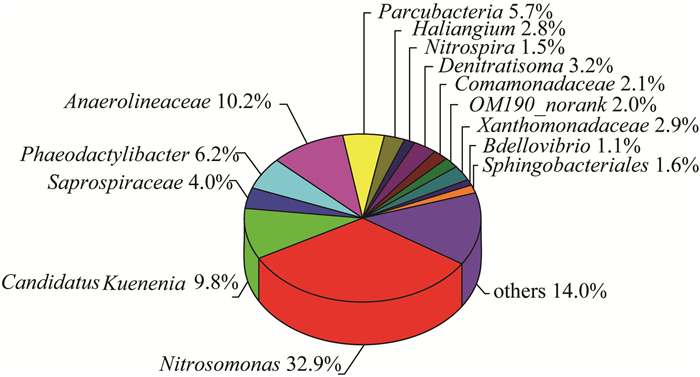
|
图 2 PN/A颗粒污泥的微生物菌群结构 Fig. 2 Microbial community structure at the genus level in the PN/A granular sludge |
当考察DO浓度的影响时, 初始NH4+-N浓度、pH和温度分别设置为(100±5) mg·L-1、8.0±0.1和(35±1)℃, 振荡转速控制在60~300 r·min-1, 对应的DO浓度范围为0.6~3.8 mg·L-1, q值的变化如图 3所示.
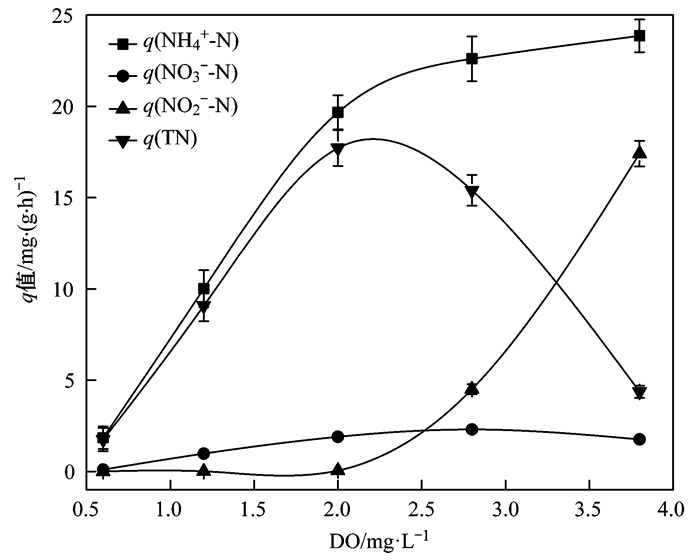
|
图 3 颗粒污泥q值随DO浓度的变化情况 Fig. 3 Variations in the q values of granules at different DO concentrations |
通常认为, 充足的DO有利于提高AOB活性, 加快亚硝化反应速率, 为AMX生长提供充足的NO2--N[13, 14], 但过高的DO浓度(氧饱和度>0.5%)又会使AMX活性明显下降[15].因此, 对于一定粒径范围的颗粒污泥而言, 必然存在最佳的DO条件以实现两类功能菌的高效协同, 换而言之, DO浓度将直接影响全自养脱氮过程的限速步骤和产物类型[16, 17].
在图 3中, 随着DO浓度的增大, 颗粒污泥的q(NH4+-N)持续上升, 同时, q(TN)呈现先升后降的变化趋势.其中, DO=2 mg·L-1对应于q(TN)的最大值[(17.7±1.0) mg·(g·h)-1], AOB与AMX之间的协同作用达到最佳.如前所述, 颗粒污泥的平均粒径达到1.0 mm且密实度良好, 较高比例的Nitrosomonas属(32.9%)及其他好氧菌也有助于增大污泥内部的氧传质阻力, 保护污泥内部AMX不受抑制.当DO < 2 mg·L-1时, AOB活性受制于供氧不足, 亚硝化反应[式(1)]成为脱氮过程中的限速步骤, q(NO2--N)值接近于零.系统中NO2--N的低产量限制了厌氧氨氧化反应[式(2)]对TN的去除.因此, DO浓度提高时, q(TN)会随着q(NH4+-N)的提升而提高.相反地, 尽管高DO条件(>2 mg·L-1)有助于提升AOB活性, 加快NH4+-N氧化速率, 使得q(NH4+-N)升高, 但过量的DO将渗透进入颗粒污泥内部, 抑制AMX活性, 使q(TN)显著降低, 并出现NO2--N累积现象.此时, 厌氧氨氧化反应成为脱氮过程的限速步骤.由式(3)可知, PN/A工艺去除1 mg NH4+-N将生成0.11 mg NO3--N, 即f(NO3--N/NH4+-N)=0.11[2].在本研究中, 各DO浓度对应的f(NO3--N/NH4+-N)均值为0.11±0.04, 与理论值接近.这说明颗粒污泥中NOB的活性较低, 生成的NO3--N主要来自厌氧氨氧化反应.
2.3 温度对功能菌协同效应的影响当考察温度的影响时, 初始NH4+-N浓度、pH和振荡转速分别设置为(100±5) mg·L-1、8.0±0.1和180 r·min-1, 温度控制在10~40℃, q值的变化如图 4所示.
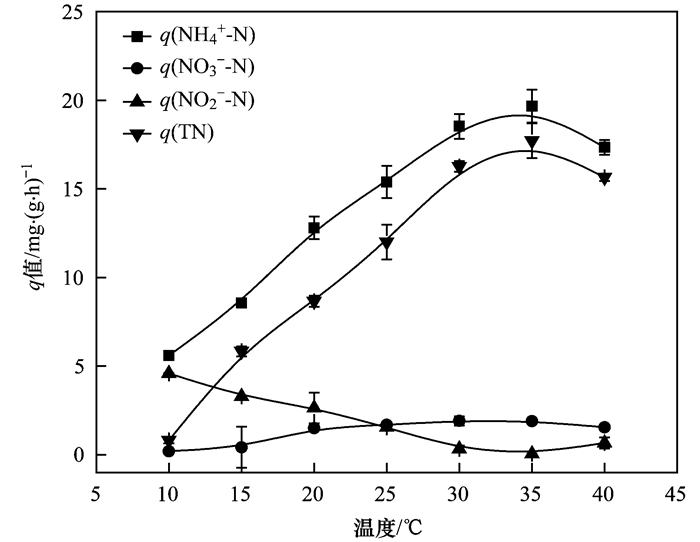
|
图 4 颗粒污泥q值随反应温度的变化情况 Fig. 4 Variations in the q values of granules at different temperatures |
根据已有报道, AOB(Nitrosomonas属)和AMX(Candidatus Kuenenia属)最适宜的生长温度分别为30~35℃[18, 19]和25~37℃[15].本研究中, 颗粒污泥去除NH4+-N和TN的最适温度在35℃左右, 该温度下AOB与AMX的协同作用达到最佳.相比之下, t=10℃对应的q(NH4+-N)和q(TN)仅分别为35℃时的28.5%和2.3%, q(NO2--N)高出q(NO3--N)近2个数量级.这表明在低温条件下, 颗粒污泥中AMX活性的受抑制程度明显高于AOB.以此类似, Laureni等也发现[20], 随着温度由25℃降至15℃时, PN/A反应器对TN的去除负荷下降了36.2%.当温度骤降至11℃时, AMX活性几乎完全被抑制.付昆明等[21]基于连续流生物膜反应器的研究也获得了类似结果.在图 4中, 当温度从10℃提高至35℃时, q(TN)的增速略高于q(NH4+-N), 同时, q(NO2--N)逐渐降低至0.05 mg·(g·h)-1以下.当温度继续升至40℃时, AOB和AMX活性均有所降低, q(NH4+-N)和q(TN)较35℃时减小约12%, 高温环境的抑制作用逐渐显现.
根据阿伦尼乌斯(Arrhenius)方程, 反应速率常数k与温度的关系可表示为:

|
(4) |
式中, Ea为反应所需活化能, J·mol-1; R为气体常数, 8.314 J·(K·mol)-1; T为热力学温度, K; k为反应速率常数.
用各温度条件下的q(NH4+-N)和q(TN)值代替式(4)中的k, 通过线型拟合可以计算对应的活化能Ea, 如图 5所示.在本研究中, 温度10~35℃下颗粒污泥去除TN的活化能Ea=86.1 kJ·mol-1, 略高于已有研究中厌氧氨氧化Ea的典型范围(63~70 kJ·mol-1)[22, 23], 约为去除NH4+-N活化能(Ea=36.6 kJ·mol-1)的2.4倍.这意味着在全自养脱氮过程中, AMX活性对温度变化更为敏感.
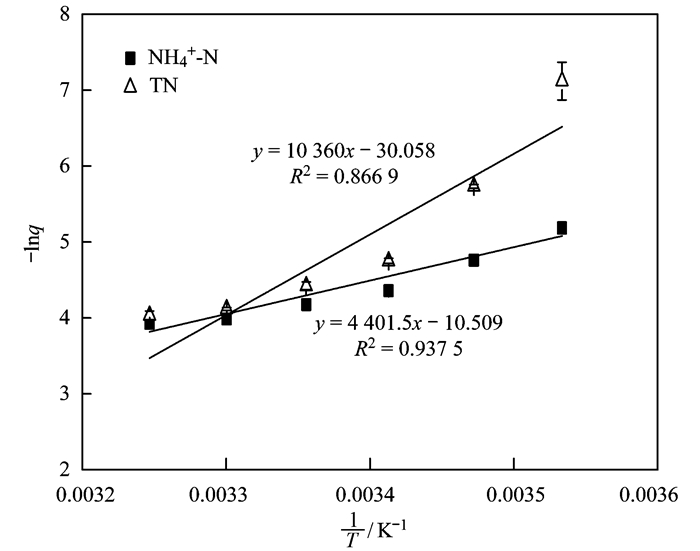
|
图 5 -lnq与1/T的相互关系 Fig. 5 Relationship between -lnq and 1/T |
需要指出的是, 经历长时间驯化过程, PN/A反应器是能够在13~15℃条件下稳定运行的, 这不仅有赖于功能菌菌群结构的演化, 也可以通过构建厚度较大的生物膜系统来实现[24, 25].已有研究中提出的相关调控经验仍需要通过实际工程的实施加以验证.
2.4 初始NH4+-N浓度对功能菌协同效应的影响当考察初始NH4+-N浓度的影响时, 溶液pH、温度和振荡转速分别设置为8.0±0.1、(35±1)℃和180 r·min-1, 初始NH4+-N浓度控制在30~500 mg·L-1, q值的变化如图 6.

|
图 6 颗粒污泥q值随初始NH4+-N浓度的变化情况 Fig. 6 Variations in the q values of granules at different initial NH4+-N concentrations |
作为AOB与AMX共同的生长基质, NH4+-N浓度的高低势必会显著影响颗粒污泥的脱氮性能.在本研究中, 当初始NH4+-N浓度为150 mg·L-1时, q(NH4+-N)和q(TN)分别达到最高的(21.4±1.0) mg·(g·h)-1和(19.0±1.3) mg·(g·h)-1.当初始NH4+-N浓度较低(< 100 mg·L-1)时, 分布于污泥表面的AOB能够利用充足的DO快速完成亚硝化步骤, 剩余的少量NH4+-N很难扩散至AMX所处的厌氧区, 厌氧氨氧化反应受到抑制, AOB与AMX的协同作用被破坏, 溶液中出现NO2--N累积现象.相应地, 将初始NH4+-N浓度逐步提高至150 mg·L-1可以有效增大基质传递的推动力, q(TN)的上升速度较q(NH4+-N)更快.但当初始NH4+-N>150 mg·L-1时, q(NH4+-N)和q(TN)又出现同步下降, 此时, q(NO2--N)始终低于0.8 mg·(g·h)-1.造成该现象的主要原因包括:首先, 在相同温度和振荡条件下, 随着初始NH4+-N浓度的增大, DO的消耗增加, 容易出现供氧不足的情况, 从而使AOB活性降低, 限制了后续厌氧氨氧化的反应速率.这与图 3中DO < 2 mg·L-1的情形非常类似.有研究表明, 同步提升进水NH4+-N浓度和DO浓度, 有利于增强PN/A颗粒污泥反应器的TN去除效能[26, 27].其次, 在pH为8.0的条件下, 随着初始NH4+-N浓度从150 mg·L-1提高至500 mg·L-1, 水中游离氨(FA)浓度从18.6 mg·L-1升至54.7 mg·L-1.这对AOB(FA抑制浓度10~150 mg·L-1)[28]和AMX(FA抑制浓度13~90 mg·L-1)[29, 30]均有潜在的抑制作用. Li等的研究表明[31], 保持进水氨氮负荷不变, 将水中FA浓度从10 mg·L-1提高至约30 mg·L-1, 会使得SBBR反应器对NH4+-N和TN的去除率分别下降44.1%和50.6%.相比之下, 分布于颗粒表面的AOB对FA的耐受性要优于厌氧区的AMX[30, 32].
2.5 溶液pH对功能菌协同效应的影响当考察溶液pH的影响时, 初始NH4+-N浓度、温度和振荡转速分别设置为(100±5) mg·L-1、(35±1)℃和180 r·min-1, 溶液pH控制在6.0~9.5, q值的变化如图 7所示.
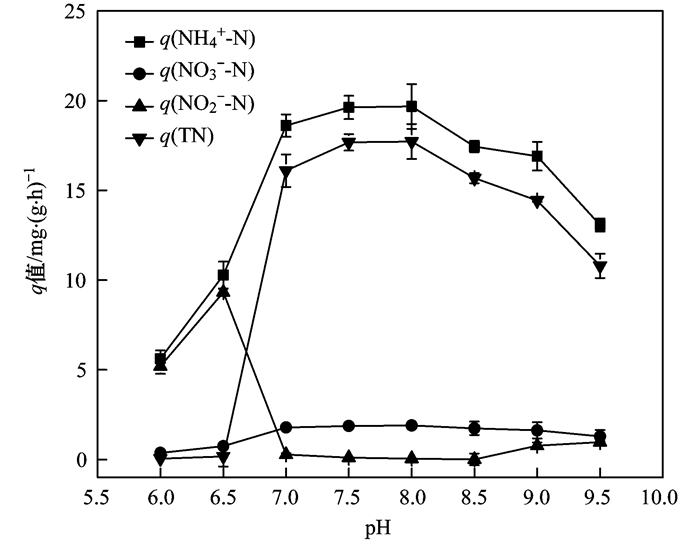
|
图 7 颗粒污泥q值随溶液pH的变化情况 Fig. 7 Variations in the q values of granules at different pH values |
有研究表明, AOB(Nitrosomonas属)和AMX(Candidatus Kuenenia属)的最适pH范围分别在7.5~8.0[23, 33]和6.5~9.0[15].在本研究中, 颗粒污泥的q(NH4+-N)和q(TN)在pH为7.0~8.5的范围内均保持在较高水平, q(NO2--N)始终低于0.3 mg·(g·h)-1, AOB与AMX之间实现了良好的协同关系.但在偏酸性条件(pH < 7.0)下, 颗粒污泥仅表现出有限的亚硝化功能, 去除的NH4+-N有超过90%转化为NO2--N, AMX的活性几乎被完全抑制.根据化学计量关系[式(3)], PN/A工艺每去除1 g NH4+-N生成H+约0.078 g, 需要消耗3.9 g的碱度(以CaCO3计).当碱度不足时, 进水无法提供充足的pH缓冲能力, 因而严重影响功能菌活性.另外, 当进水pH超过8.5时, 颗粒污泥的脱氮性能出现下降趋势.进水pH 9.5对应的q(NH4+-N)和q(TN)分别比pH=8.0时下降了36.1%和41.3%, 溶液中出现少量NO2--N累积.此时, 进水FA浓度高达92.1 mg·L-1, 对AOB与AMX活性均有抑制作用[28~30].
3 结论(1) 高通量测序的结果表明, 在全自养脱氮颗粒污泥(平均粒径约为1.0 mm)中, AOB(Nitrosomonas属)与AMX(Candidatus Kuenenia属)占据优势地位, 分别占到细菌总数的32.9%和9.8%, 同时, NOB的生长得到充分抑制, 相对丰度仅为1.5%.
(2) 当初始NH4+-N浓度为100 mg·L-1时, AOB与AMX之间的协同作用在DO=2 mg·L-1时达到最佳.当DO < 2 mg·L-1时, 亚硝化反应成为PN/A工艺的限速步骤.反之, DO>2 mg·L-1会明显抑制AMX活性, 导致溶液中出现NO2--N累积.
(3) 颗粒污泥脱氮的最适温度在35℃左右, AOB与AMX的协同效应达到最优.污泥去除TN的活化能Ea约为去除NH4+-N的2.4倍, 这意味着AMX对低温条件更加敏感.当温度为10℃时, 颗粒污泥仅表现出有限的亚硝化功能.
(4) 当初始NH4+-N浓度低于100 mg·L-1时, AMX活性将受制于颗粒内部的基质扩散.随着初始NH4+-N浓度的提高, AOB与AMX的协同效应增强.但在初始NH4+-N>150 mg·L-1的条件下, 供氧不足和高FA浓度又会导致污泥脱氮性能下降.
(5) 颗粒污泥脱氮的最适pH范围在7.0~8.5. pH<7.0时, 溶液无法提供充足的缓冲能力, AMX活性将被完全抑制.相应地, pH>8.5导致的高FA也会影响AOB与AMX的协同作用.
| [1] | Sinha B, Annachhatre A P. Partial nitrification-operational parameters and microorganisms involved[J]. Reviews in Environmental Science and Bio/technology, 2007, 6(4): 285-313. DOI:10.1007/s11157-006-9116-x |
| [2] | Third K A, Sliekers A O, Kuenen J G, et al. The CANON system (Completely Autotrophic Nitrogen-removal Over Nitrite) under ammonium limitation:interaction and competition between three groups of bacteria[J]. Systematic and Applied Microbiology, 2001, 24(4): 588-596. DOI:10.1078/0723-2020-00077 |
| [3] | Morales N, Val del Río A, Vázquez-Padín J R, et al. Integration of the Anammox process to the rejection water and main stream lines of WWTPs[J]. Chemosphere, 2015, 140: 99-105. DOI:10.1016/j.chemosphere.2015.03.058 |
| [4] | Qian F Y, Wang J F, Shen Y L, et al. Achieving high performance completely autotrophic nitrogen removal in a continuous granular sludge reactor[J]. Biochemical Engineering Journal, 2017, 118: 97-104. DOI:10.1016/j.bej.2016.11.017 |
| [5] | Wang L, Zheng P, Chen T T, et al. Performance of autotrophic nitrogen removal in the granular sludge bed reactor[J]. Bioresource Technology, 2012, 123: 78-85. DOI:10.1016/j.biortech.2012.07.112 |
| [6] |
李冬, 苏庆岭, 梁瑜海, 等. CANON颗粒污泥高效脱氮及处理生活污水实验研究[J]. 哈尔滨工业大学学报, 2015, 47(8): 79-86. Li D, Su Q L, Liang Y H, et al. Efficient nitrogen removal from domestic wastewater by CANON granular sludge[J]. Journal of Harbin Institute of Technology, 2015, 47(8): 79-86. DOI:10.11918/j.issn.0367-6234.2015.08.016 |
| [7] | Lv Y T, Wang L, Sun T, et al. Autotrophic nitrogen removal discovered in suspended nitritation system[J]. Chemosphere, 2010, 79(2): 180-185. DOI:10.1016/j.chemosphere.2010.02.007 |
| [8] | Daverey A, Su S H, Huang Y T, et al. Partial nitrification and anammox process:a method for high strength optoelectronic industrial wastewater treatment[J]. Water Research, 2013, 47(9): 2929-2937. DOI:10.1016/j.watres.2013.01.028 |
| [9] | Lackner S, Gilbert E M, Vlaeminck S E, et al. Full-scale partial nitritation/anammox experiences-an application survey[J]. Water Research, 2014, 55: 292-303. DOI:10.1016/j.watres.2014.02.032 |
| [10] |
王书永, 钱飞跃, 王建芳, 等. 有机物对亚硝化颗粒污泥中功能菌活性的影响[J]. 环境科学, 2017, 38(1): 269-275. Wang S Y, Qian F Y, Wang J F, et al. Impact of biodegradable organic matter on the functional microbe activities in partial nitrification granules[J]. Environmental Science, 2017, 38(1): 269-275. |
| [11] | Suzuki I, Dular U, Kwok S C. Ammonia or ammonium ion as substrate for oxidation by Nitrosomonas europaea cells and extracts[J]. Journal of Bacteriology, 1974, 120(1): 556-558. |
| [12] | Wang J F, Qian F Y, Liu X P, et al. Cultivation and characteristics of partial nitrification granular sludge in a sequencing batch reactor inoculated with heterotrophic granules[J]. Applied Microbiology and Biotechnology, 2016, 100(21): 9381-9391. DOI:10.1007/s00253-016-7797-9 |
| [13] | Laanbroek H J, Bodelier P L E, Gerards S. Oxygen consumption kinetics of Nitrosomonas europaea and Nitrobacter hamburgensis grown in mixed continuous cultures at different oxygen concentrations[J]. Archives of Microbiology, 1994, 161(2): 156-162. DOI:10.1007/BF00276477 |
| [14] | Van Hulle S W H, Vandeweyer H J P, Meesschaert B D, et al. Engineering aspects and practical application of autotrophic nitrogen removal from nitrogen rich streams[J]. Chemical Engineering Journal, 2010, 162(1): 1-20. DOI:10.1016/j.cej.2010.05.037 |
| [15] | Oshiki M, Satoh H, Okabe S. Ecology and physiology of anaerobic ammonium oxidizing bacteria[J]. Environmental Microbiology, 2016, 18(9): 2784-2796. DOI:10.1111/1462-2920.13134 |
| [16] | Vlaeminck S E, Terada A, Smets B F, et al. Aggregate size and architecture determine microbial activity balance for one-stage partial nitritation and anammox[J]. Applied and Environmental Microbiology, 2010, 76(3): 900-909. DOI:10.1128/AEM.02337-09 |
| [17] | Hubaux N, Wells G, Morgenroth E. Impact of coexistence of flocs and biofilm on performance of combined nitritation-anammox granular sludge reactors[J]. Water Research, 2015, 68: 127-139. DOI:10.1016/j.watres.2014.09.036 |
| [18] | Hellinga C, Schellen A A J C, Mulder J W, et al. The sharon process:an innovative method for nitrogen removal from ammonium-rich waste water[J]. Water Science and Technology, 1998, 37(9): 135-142. |
| [19] | Shalini S S, Joseph K. Nitrogen management in landfill leachate:application of SHARON, ANAMMOX and combined SHARON-ANAMMOX process[J]. Waste Management, 2012, 32(12): 2385-2400. DOI:10.1016/j.wasman.2012.06.006 |
| [20] | Laureni M, Falås P, Robin O, et al. Mainstream partial nitritation and anammox:long-term process stability and effluent quality at low temperatures[J]. Water Research, 2016, 101: 628-639. DOI:10.1016/j.watres.2016.05.005 |
| [21] |
付昆明, 张杰, 曹相生, 等. CANON反应器运行稳定性及温度冲击的影响[J]. 环境科学, 2012, 33(10): 3507-3512. Fu K M, Zhang J, Cao X S, et al. Performance stability of CANON reactor and temperature impact[J]. Environmental Science, 2012, 33(10): 3507-3512. |
| [22] | Dosta J, Fernández I, Vázquez-Padín J R, et al. Short-and long-term effects of temperature on the Anammox process[J]. Journal of Hazardous Materials, 2008, 154(1-3): 688-693. DOI:10.1016/j.jhazmat.2007.10.082 |
| [23] | Strous M, Kuenen J G, Jetten M S M. Key physiology of anaerobic ammonium oxidation[J]. Applied and Environmental Microbiology, 1999, 65(7): 3248-3250. |
| [24] | Gilbert E M, Agrawal S, Schwartz T, et al. Comparing different reactor configurations for Partial Nitritation/Anammox at low temperatures[J]. Water Research, 2015, 81: 92-100. DOI:10.1016/j.watres.2015.05.022 |
| [25] | De Clippeleir H, Vlaeminck S E, De Wilde F, et al. One-stage partial nitritation/anammox at 15℃ on pretreated sewage:feasibility demonstration at lab-scale[J]. Applied Microbiology and Biotechnology, 2013, 97(23): 10199-10210. DOI:10.1007/s00253-013-4744-x |
| [26] | Wang S P, Liu Y, Niu Q G, et al. Nitrogen removal performance and loading capacity of a novel single-stage nitritation-anammox system with syntrophic micro-granules[J]. Bioresource Technology, 2017, 236: 119-128. DOI:10.1016/j.biortech.2017.03.164 |
| [27] |
孙延芳, 韩晓宇, 张树军, 等. CANON颗粒污泥工艺的启动与负荷提高策略[J]. 环境科学, 2017, 38(8): 3429-3434. Sun Y F, Han X Y, Zhang S J, et al. Start-up of granule CANON process and the strategy for enhancing total nitrogen removal rate[J]. Environmental Science, 2017, 38(8): 3429-3434. |
| [28] | Anthonisen A C, Loehr R C, Prakasam T B, et al. Inhibition of nitrification by ammonia and nitrous acid[J]. Journal-Water Pollution Control Federation, 1976, 48(5): 835-852. |
| [29] | Waki M, Tokutomi T, Yokoyama H, et al. Nitrogen removal from animal waste treatment water by anammox enrichment[J]. Bioresource Technology, 2007, 98(14): 2775-2780. DOI:10.1016/j.biortech.2006.09.031 |
| [30] | Fernández I, Dosta J, Fajardo C, et al. Short-and long-term effects of ammonium and nitrite on the anammox process[J]. Journal of Environmental Management, 2012, 95(S): S170-S174. |
| [31] | Li S, Chen Y P, Li C, et al. Influence of free ammonia on completely autotrophic nitrogen removal over nitrite (CANON) process[J]. Applied Biochemistry and Biotechnology, 2012, 167(4): 694-704. DOI:10.1007/s12010-012-9726-4 |
| [32] | Wu L, Peng Y Z, Ma Y, et al. The short-term effects of temperature and free ammonia on ammonium oxidization in granular and floccular nitrifying system[J]. Chinese Journal of Chemical Engineering, 2012, 20(5): 1016-1023. DOI:10.1016/S1004-9541(12)60431-5 |
| [33] | Tao W D, He Y L, Wang Z Y, et al. Effects of pH and temperature on coupling nitritation and anammox in biofilters treating dairy wastewater[J]. Ecological Engineering, 2012, 47(5): 76-82. |
 2018, Vol. 39
2018, Vol. 39


